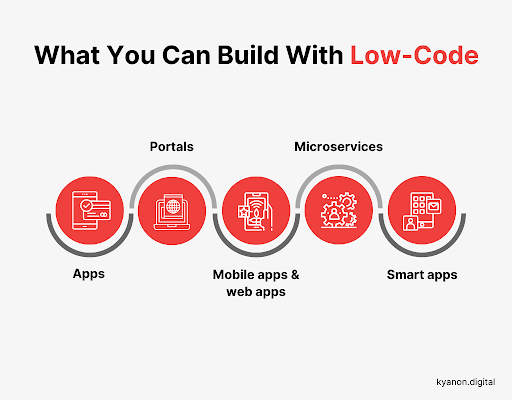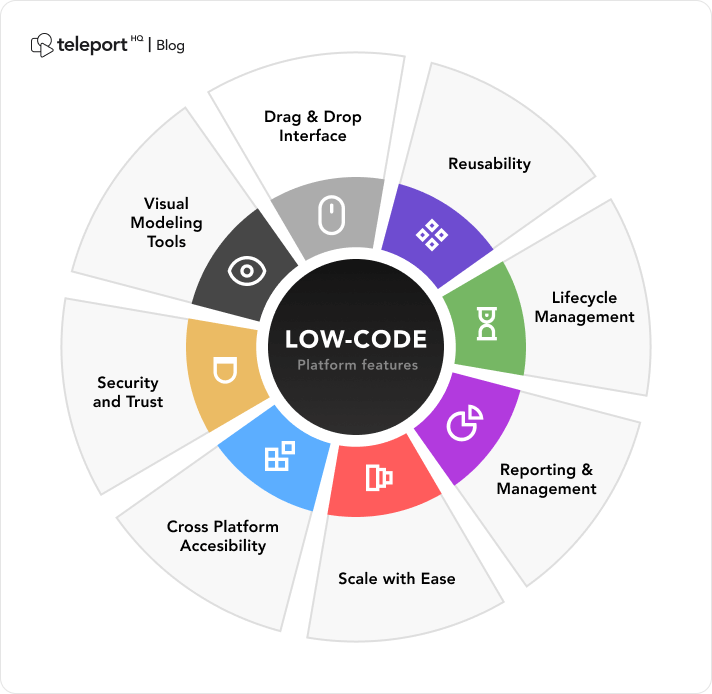Great News For Picking Legacy application modernization with Low-code
Great News For Picking Legacy application modernization with Low-code
Blog Article
The Benefits Of Low-Code Programming For Application Development In Relation To Is Related To Integration Capabilities
Low-code development is an excellent way to build applications that seamlessly integrate with different systems and services. Here are the major advantages: Pre-built Connectors and APIs:
A wide range of connectors available Low-code platforms include a large collection of pre-built connectors to popular enterprise system (e.g. CRM, ERP databases, cloud services). It simplifies the integration with these systems.
API Integration: A lot of platforms have built-in API integration features. This allows developers to quickly connect to external data and services.
User-friendly:
Drag-and-Drop Integration: Many integration tasks are completed by using drag-and-drop interfaces. This lets developers and nondevelopers to create complicated integrations with minimal or no programming.
Visual Workflow Builders: Visual tools for designing workflows and data flows help in understanding and setting up integrations with greater ease.
Standardized Integration Methods:
SOAP and RESTful Services Support for web services protocols like SOAP and REST allows for easy integration with a variety of external systems and applications.
OData Standards and other Standards The support for standards, such as OData permits the easy access of data and its manipulation across different platforms and applications.
Real-Time Data Synchronization:
Real-Time Integrations: Low-code platforms can handle real-time data sync between applications and systems. This guarantees that data is up to date and consistent across the entire organization.
Event-Driven Architecture: Certain platforms can support event-driven architectures. which allow applications to react to events in real-time. This is vital for dynamic and interactive applications.
Legacy System Integration:
Low-code platforms are often utilized to integrate older systems. This allows organizations to modernize IT infrastructures without the need for a complete overhaul of existing systems.
Data Migration Tool: Built-in data migration tools let data be transferred from older systems into new applications that are built on low code platforms.
Third-Party service integration:
Cloud Services: Seamless Integration with Cloud Services such as AWS Azure Google Cloud and Google Cloud makes it easy to deploy applications.
Business Integration of Applications: Low code platforms can be integrated with various business software like Salesforce, SAP and Microsoft Dynamics. This allows for a seamless workflow between the business processes.
Simplified Data management:
Unified Data Models: Some low-code platforms provide unified data modeling which makes data integration easier and management across multiple systems.
Data Connectors are pre-configured data connectors that offer rapid access to sources of data and permit manipulation.
Security and Compliance:
Low-code integration platforms adhere to security standards to protect the data during transport or in storage.
Compliance Features: These platforms usually have features to assure that integrations are in compliance with regulations, for example GDPR and HIPAA. This provides security for companies handling sensitive data.
Extensibility:
Custom Codes and scripts. For more complex needs for integration, low-code platforms usually allows the use of custom code and scripts. This gives flexibility but without compromising user comfort.
Plug-in Ecosystem An ecosystem of extensions and plugins can extend integration capabilities by allowing users to implement new functions as they are needed.
Overall, the capabilities for integration of low-code application development platforms makes them a powerful device for building interconnected, efficient and scalable applications. They make it easier to connecting different systems, improve data flow and allow companies to take advantage of innovative technologies while also leveraging existing ones. Check out the best Low-code Platform for application development tips for site examples including driver jdbc, push alerts, software for app development, jdbc server, app modernisation, azure sql, multiplatform mobile app development, stored sql procedures, cloud software applications, app modernization and more.![]()
Benefits Low-Code Apps In Safety And Governance
Low-code applications offer a number of advantages in terms of governance and security. Both are essential for ensuring that applications are in compliance, safe and managed well throughout their lifespan. These are the benefits of developing low-code applications:
Unified Manage Console: Lowcode platforms generally offer a management console that allows administrators to manage and supervise applications.
Role-Based Access Control: These platforms offer robust role-based access control that allows administrators to define guidelines and then enforce these policies. It ensures that only users with authorization can modify or access specific parts of the software.
Compliance and Regulatory Applicability:
Built-in Compliance Features: Many low-code platforms are built to comply with industry standards as well as regulations (e.g., GDPR, HIPAA). They have frameworks and tools to help ensure that applications meet these requirements.
Audit Trails and Logging: Complete logging, audit trails, and logs are often integrated into companies that allow them to keep track of changes and track access. They also can ensure compliance of both external and internal rules and regulations.
Additional Security Measures
Data Encryption: Low-code systems typically provide built-in encryption for data that is in storage and while in transit, making sure that data with sensitive information is secure.
Security Certifications: Many providers of low-code software have security certifications such as ISO 27001 or SOC 2 to prove that they are able to meet the highest standards. These certificates offer additional assurances to users.
Automated security updates
Regular patches and updates Low-code platforms can handle the majority of security patches and updates in a way. They ensure that apps are protected from the latest threats without having developers intervene manually.
Security Monitoring: Tools for constant security monitoring are available. They send immediate alerts and insight into security issues that might arise.
Data Governance
Data Access Policies: These platforms allow organisations to create and enforce data access policies which ensure that data is only accessible only to those who have been granted access and is properly used.
Data Masking and Anonymization Built-in tools for data masking and anonymization can help safeguard sensitive information, especially when working in testing and development environments.
Consistent Lifecycle Management of Applications
Pipelines for development and delivery: Low-code platforms often have integrated development pipelines and delivery pipelines which incorporate security tests. Security is ensured throughout the lifecycle.
Version Control: An integrated version control system is used to manage changes, allowing any changes that are made to an application to be monitored. If required the changes can be reversed and the integrity of the application ensured.
User Authentication and Authorization:
Single Sign-On (SSO). Support for advanced authentication and single sign-on simplifies and increases security.
Multi-Factor Authentication Numerous platforms allow multi-factor Authentication that adds an extra layer to security when accessing applications.
Monitoring of Policy Enforcement and Compliance:
Policy Templates: Low code platforms often include pre-defined templates for governance and security that allow organizations to quickly adopt policies.
Compliance Monitoring Tools: These give continuous monitoring and a report on the status of compliance. This allows you to detect potential issues and address them proactively.
Integration into Existing Security Infrastructure
Seamless Intergration: Low-code platforms are designed to facilitate seamless integration with existing security tools and equipment, including Identity Management Systems, SIEM Solutions (Security Information and Event Management), and Firewalls.
API Security: Integrated API security ensures integrations with external system are secured. Secure data and ensure application consistency.
Training and Best practices
Guided Best Practices: A number of platforms provide guidelines and best methods for secure application development that help developers who are not developers to adhere to security guidelines.
Security Training: A few low-code vendors offer security training as well as tools to help users learn how to design and build secure applications.
Overall, the application's governance and security benefits guarantee that applications are built and managed securely, in compliance with regulations, and under control. These platforms provide the frameworks and tools necessary to secure sensitive data and enforce policies, as well as maintain compliance with regulations while reducing management and oversight. Follow the recommended great site about Legacy application modernization with Low-code for more examples including ms azure sql, develop web application, application modernisation, rad development, mobile development platforms, rapid app development, cross platform mobile dev, software for app development, application modernization, rad application development and more.
Low-Code Apps Have Many Advantages In Terms Collaboration And Workflow
Low-code development can offer many benefits in collaboration and workflow. This makes it an ideal solution for businesses seeking to improve productivity and streamline the process of development. Here are some of the most important benefits: Improved cross-functional collaboration:
Unified Development Environment. Low-code platforms let all team members collaborate in a single, unified environment. This includes developers, business analyst and designers as well as stakeholder. It eliminates silos while fostering greater communication.
Visual Development Tools Low-code platforms are simple to use and feature the drag-and-drop interface. This lets non-technical people on the team to be involved during the development process and ensures that business requirements can be captured precisely.
Communication Enhanced:
Real-Time Co-operation: Many platforms with low-code support real-time collaboration features such as commenting, editing in parallel and getting immediate feedback. They allow for continuous communication by reducing the amount of time required for back-and-forth discussions.
Shared Workspaces: Teams are able to work together in shared workspaces, where they can view, edit, and discuss elements of the project, making sure everyone's on the same page, and working towards the same goals.
Workflow management simplified:
Built-In Project Management Tools: Low-code platforms usually have integrated project management tools that help teams plan to track and manage their development projects. This includes the assigning of tasks, tracking progress, and managing deadlines.
Workflow automation: The automation of routine work, workflows, and other processes decreases the manual effort required and eliminates mistakes. This lets teams concentrate on more valuable tasks and improves efficiency.
Faster Iteration Cycles
Rapid prototyping. A low-code platform allows quick prototyping. This means feedback can be integrated quickly and improvements can be made.
Support for Agile Development: Supporting agile practices allow teams to collaborate continuously during sprints. This allows them to adapt and deliver small incremental improvements to capabilities.
Accessibility:
Citizens Development: Lowcode platforms enable people who use business software (citizen developers) to develop as well as modify and maintain applications that do not require a lot of code. This alleviates the burden of IT as well as development teams and can provide faster responses to business requirements.
Training and Onboarding. The user-friendly interfaces of the training tools make it easy for the new members to be familiar with the system and this improves collaboration.
Centralized Documentation and Knowledge Sharing:
Documentation is integrated: Low code platforms usually come with features to create and manage documentation on the platform, allowing for all project details to be centralized.
Knowledge Repositories: Teams are able to build and maintain knowledge repositories that include the best practices, templates and reuseable components, helping to facilitate sharing of knowledge and reducing the duplication of effort.
Consistency in Standardization
Standardized components: Standardized, pre-built component ensures consistency in applications. Team members are able to understand and work better on various parts.
Governance and Governance and Compliance: Built-in governance frameworks ensure that all development follows organizational standards and regulatory requirements which reduces the chance of non-compliance, and ensuring that applications meet quality standards.
Feedback Loops and Improvement Loops
Integrated Feedback Mechanisms Low-code platforms typically have integrated feedback mechanisms, allowing users to provide easy feedback to applications. This can later be integrated into the development process.
Continuous Improvement: The capability of rapidly implementing modifications based on feedback assures that applications are constantly developed, while being in tune with the requirements and goals of users.
Visualization, Reporting and Analysis
Real-time Analytics: In-built analysis and reporting provides real-time insights into project performance, user interactions and development. Data-driven decision-making is possible.
Visual Workflow Maps Software for mapping workflows or processes are useful to teams in understanding their workflows. They can also be used to pinpoint the bottlenecks that are present, as well as areas that require improvement.
For collaboration, low-code apps are ideal for reducing workflows, bring teams from different backgrounds together and automate tasks. This encourages a collaborative environment with an agile and efficient process for development, which results in more high-quality apps as well as a better alignment between goals of business.